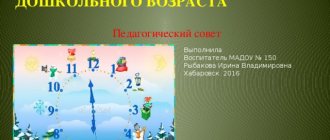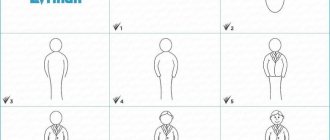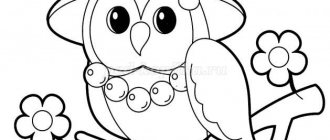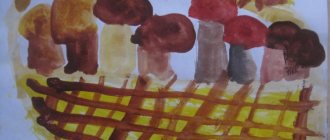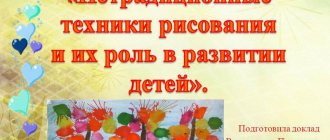On the topic: methodological developments, presentations and notes
To study the process of development of children's creative abilities using non-traditional drawing techniques; to form an aesthetic attitude towards the surrounding reality based on familiarization with non-traditional drawing techniques.
“Non-traditional drawing techniques in early preschool age.”
Dear Colleagues! I have been practicing visual arts in kindergarten for several years now, using non-traditional methods of depiction. I am very pleased with the children's eyes, delighted with surprise.
Presentation on the topic “Unconventional drawing techniques.”
Presentation on the topic: “Unconventional drawing techniques.”
Presentation on the topic “Non-traditional drawing techniques in different age groups of kindergarten.”
Consultation for parents on the topic: “Non-traditional artistic drawing techniques.”
Slide captions:
MKDOU "Oktyabrsky kindergarten "Firefly" Moshkovsky district NON-TRADITIONAL DRAWING TECHNIQUES
“And at ten years old, and at seven, and at five All children love to draw. And everyone will boldly draw everything that interests him...” Valentin Berestov
the most important means of aesthetic education. The most important task of aesthetic education is ways of creating a new, original work of art in which everything is in harmony: color, line, and plot. This is a huge opportunity for children to think, try, search, experiment. And the most important thing is to express yourself. Drawing Unconventional drawing techniques
The use of non-traditional techniques in art activities helps to enrich children's knowledge and ideas about objects and their use, materials, their properties, methods of application; stimulates positive motivation in the child, causes a joyful mood, removes fear of the drawing process; provides the opportunity to experiment; develops tactile sensitivity, color discrimination; promotes the development of hand-eye coordination; does not tire preschoolers, increases performance; develops unconventional thinking, emancipation, and individuality.
Methods of depiction Non-traditional methods of depiction in drawing Drawing with your own hands (fingers, palm) Drawing with a stamp (pin drawing, imprint) Drawing with a candle Blowing paint Drawing with duct tape Monotopy And much more Plasticineography Scratch Drawing with a comb Blotography
Drawing with your own hands (fingers, palm) Age: from two years. Means of expression: spot, color, fantastic silhouette. Materials: wide saucers with gouache, brush, thick paper of any color, large format sheets, napkins. Method of obtaining an image: a child dips his palm (finger) into gouache or paints it with a brush (from the age of five) and makes an imprint on paper. They draw with both the right and left hands, painted in different colors. After work, wipe your hands with a napkin, then the gouache is easily washed off.
Foam rubber impression Age: from four years. Means of expression: stain, texture, color. Materials: a bowl or plastic box containing a stamp pad made of thin foam rubber impregnated with gouache, thick paper of any color and size, pieces of foam. Method of obtaining an image: a child presses polystyrene foam onto a stamp pad with paint and makes an impression on paper. To get a different color, change both the bowl and the foam.
Leaf prints Age: from five years. Means of expression: texture, color. Materials: paper, leaves of various trees (preferably fallen), gouache, brushes. Method of obtaining an image: the child covers a piece of wood with paints of different colors, then applies it to the paper with the painted side to obtain a print. Each time a new leaf is taken. The petioles of the leaves can be painted on with a brush.
Tamponing with cotton swabs Age: from 2 years. Means of expression: stain, texture, color. Materials: saucer or plastic box containing a stamp pad made of thin foam rubber impregnated with gouache, thick paper of any color and size, crumpled paper. Method of obtaining an image: a child applies paint to paper using cotton swabs (using the poking method).
Wax crayons (candle) + watercolor Age: from four years. Means of expression: color, line, spot, texture. Materials: wax crayons, thick white paper, watercolor, brushes. Method of obtaining an image: the child draws with wax crayons on white paper. Then he paints the sheet with watercolors in one or more colors. The chalk drawing remains unpainted. Materials: candle, thick paper, watercolor, brushes. Method of obtaining an image: the child draws with a candle on paper. Then he paints the sheet with watercolors in one or more colors. The candle pattern remains white.
Regular blotography Age: from five years. Means of expression: stain. Materials: paper, ink or thinly diluted gouache in a bowl, plastic spoon. Method of obtaining an image: the child scoops up gouache with a plastic spoon and pours it onto paper. The result is spots in a random order. Then the sheet is covered with another sheet and pressed (you can bend the original sheet in half, drip ink onto one half, and cover it with the other). Next, the top sheet is removed, the image is examined: it is determined what it looks like. The missing details are completed.
Blotography with a tube Age: from five years. Means of expression: stain. Materials: paper, ink or thinly diluted gouache in a bowl, plastic spoon. Method of obtaining an image: the child scoops up gouache with a plastic spoon and pours it onto paper. Then blow on this stain from a tube so that its end does not touch either the stain or the paper. If necessary, the procedure is repeated. The missing details are completed.
Drawing with grains (salt) Age: from six years. Means of expression: volume. Materials: salt, clean sand or semolina, PVA glue, cardboard, glue brushes, a simple pencil. Method of obtaining: The child prepares cardboard of the desired color, draws the required design with a simple pencil, then smears each item in turn with glue and carefully sprinkles with salt (cereals), pours the excess onto a tray.
Scratchboard (primed sheet) Age: from 5 years Means of expression: line, stroke, contrast. Materials: semi-cardboard or thick white paper, a candle, a wide brush, black mascara, liquid soap (about one drop per tablespoon of mascara) or tooth powder, bowls for mascara, a stick with sharpened ends. Method of obtaining an image: the child rubs a sheet with a candle so that it is completely covered with a layer of wax. Then mascara with liquid soap or tooth powder is applied to it, in which case it is filled with mascara without additives. After drying, the design is scratched with a stick.
Drawing on wet Age: from five years. Means of expression: point, texture. Materials: paper, gouache, hard brush, piece of thick cardboard or plastic (5x5 cm). Method of obtaining an image: 1. drawing on a specific topic: landscape, walk, animals, flowers, etc. - when the drawing is created on a wet sheet, 2. drawing a background for the future drawing, when the colors spread, connecting and shimmering with each other, creating a pattern , which determines the theme of further drawing “dry”
Drawing with electrical tape Age: from 5 years Means of expression: line, contrast. Materials: semi-cardboard, or thick white paper, gouache, insulating tape. Method of obtaining an image: the child glues the elements of the picture using electrical tape. Paints a sheet of paper. After complete drying, carefully remove the isolette.

